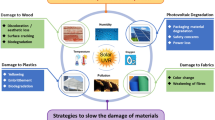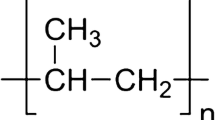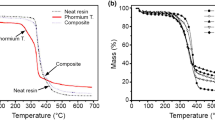Abstract
This study aims to develop a general model to examine the weathering-induced degradation of a polycarbonate/acrylonitrile–butadiene–styrene (PC/ABS) blend under various temperatures and UV irradiance levels. The carbonyl index (CI) was measured with respect to the diverse conditions by Fourier-transform infrared (FT-IR) spectroscopy. Then, a response surface model for the CI with respect to the temperature and UV irradiance was established. The glossiness, tensile properties, and Izod impact resistance were measured under various weathering conditions. The fracture properties were also tested using the essential work of fracture (EWF) method. The correlations between these properties and the CI were determined. The results show that the fracture toughness and crack growth resistance measured by the EWF tests were significantly reduced even at a low CI level, i.e., the early degradation stage, whereas the tensile properties and impact resistance did not noticeably change. Although the tensile properties and impact resistances maintained their initial properties until a certain CI value, the fracture characteristics degraded rapidly, even at the initial degradation level. The model was verified by comparison with samples weathered outdoors for four and six months in Seoul, Republic of Korea. It was confirmed that the model for the Izod impact strength (IZOD) with a CI function can predict the experimental IZOD data for the outdoor-weathered specimens using the predicted CI values, with an error of 5.6%.


















Similar content being viewed by others
Availability of Data and Material
The raw/processed data required to reproduce these findings cannot be shared at this time, as the data also forms part of an ongoing study.
Code Availability
Not Applicable.
References
Barlow, J. W., & Paul, D. R. (1981). Polymer blends and alloys—a review of selected considerations. Polymer Engineering & Science, 21(15), 985–996.
Huang, J. C., & Wang, M. S. (1989). Recent advances in ABS/PC blends. Advances in Polymer Technology: Journal of the Polymer Processing Institute, 9(4), 293–299.
Keitz, J. D., Barlow, J. W., & Paul, D. R. (1984). Polycarbonate blends with styrene/acrylonitrile copolymers. Journal of Applied Polymer Science, 29(10), 3131–3145.
Suarez, H., Barlow, J. W., & Paul, D. R. (1984). Mechanical properties of ABS/polycarbonate blends. Journal of Applied Polymer Science, 29(11), 3253–3259.
Tjong, S. C., & Meng, Y. Z. (2000). Effect of reactive compatibilizers on the mechanical properties of polycarbonate/poly (acrylonitrile–butadiene–styrene) blends. European Polymer Journal, 36(1), 123–129.
Balart, R., Lopez, J., García, D., & Salvador, M. D. (2005). Recycling of ABS and PC from electrical and electronic waste. Effect of miscibility and previous degradation on final performance of industrial blends. European Polymer Journal, 41(9), 2150–2160.
Jeon, S. H., Choi, W. C., Park, T. H., Kim, H. M., Jung, E. I., Baek, C. K., Seo, K. J., & Choi, B. H. (2012). Development of a new light-weight car audio using polycarbonate/acrylonitrile–butadiene–styrene copolymer composite based hybrid material. International Journal of Precision Engineering and Manufacturing, 13, 85–96.
Greco, R., & Sorrentino, A. (1994). Polycarbonate/ABS blends: A literature review. Advances in Polymer Technology: Journal of the Polymer Processing Institute, 13(4), 249–258.
Levchik, S. V., & Weil, E. D. (2006). Flame retardants in commercial use or in advanced development in polycarbonates and polycarbonate blends. Journal of Fire Sciences, 24(2), 137–151.
Feldman, D. (2002). Polymer weathering: Photo-oxidation. Journal of Polymers and the Environment, 10(4), 163–173.
Shah, A. U. R., Prabhakar, M. N., & Song, J. I. (2017). Current advances in the fire retardancy of natural fiber and bio-based composites—A review. International Journal of Precision Engineering and Manufacturing-Green Technology, 4, 247–262.
Pickett, J. E., Gardner, M. M., Gibson, D. A., & Rice, S. T. (2005). Global weathering of aromatic engineering thermoplastics. Polymer Degradation and Stability, 90(3), 405–417.
Satoto, R., Subowo, W. S., Yusiasih, R., Takane, Y., Watanabe, Y., & Hatakeyama, T. (1997). Weathering of high-density polyethylene in different latitudes. Polymer Degradation and Stability, 56(3), 275–279.
Wee, J. W., Choi, M. S., Hyun, H. C., Hwang, J. H., & Choi, B. H. (2018). Effect of weathering-induced degradation on the fracture and fatigue characteristics of injection-molded polypropylene/talc composites. International Journal of Fatigue, 117, 111–120.
Mendes, L. C., Rufino, E. S., De Paula, F. O., & Torres, A. C., Jr. (2003). Mechanical, thermal and microstructure evaluation of HDPE after weathering in Rio de Janeiro City. Polymer Degradation and Stability., 79(3), 371–383.
Allen, N. S., Mudher, M., & Green, P. (1984). Photo-stabilising action of ortho-hydroxy aromatic compounds in polypropylene film: UV absorption versus radical scavenging. Polymer Degradation and Stability, 7(2), 83–94.
Gulmine, J. V., Janissek, P. R., Heise, H. M., & Akcelrud, L. (2003). Degradation profile of polyethylene after artificial accelerated weathering. Polymer Degradation and Stability, 79(3), 385–397.
Zhao, B. Y., Yi, X. W., Li, R. Y., Zhu, P. F., & Hu, K. A. (2003). Characterization to the weathering extent of LLDPE/LDPE thin film. Journal of Applied Polymer Science, 88(1), 12–16.
Lv, Y., Huang, Y., Yang, J., Kong, M., Yang, H., Zhao, J., & Li, G. (2015). Outdoor and accelerated laboratory weathering of polypropylene: A comparison and correlation study. Polymer Degradation and Stability, 112, 145–159.
Diepens, M., & Gijsman, P. (2011). Outdoor and accelerated weathering studies of bisphenol A polycarbonate. Polymer Degradation and Stability., 96(4), 649–652.
Pickett, J. E., Gibson, D. A., Rice, S. T., & Gardner, M. M. (2008). Effects of temperature on the weathering of engineering thermoplastics. Polymer Degradation and Stability., 93(3), 684–691.
Tjandraatmadja, G. F., Burn, L. S., & Jollands, M. C. (2002). Evaluation of commercial polycarbonate optical properties after QUV-A radiation—the role of humidity in photodegradation. Polymer Degradation and Stability, 78(3), 435–448.
Kaplan, M. L., & Kelleher, P. G. (1970). Photo-oxidation of polymers without light: Oxidation of polybutadiene and an ABS polyblend with singlet oxygen. Journal of Polymer Science Part A 1: Polymer Chemistry, 8(11), 3163–3175.
Ghaemy, M., & Scott, G. (1981). Photo-and thermal oxidation of ABS: Correlation of loss of impact strength with degradation of the rubber component. Polymer Degradation and Stability, 3(3), 233–242.
Coquillat, M., Verdu, J., Colin, X., Audouin, L., & Nevière, R. (2007). Thermal oxidation of polybutadiene. Part 1: Effect of temperature, oxygen pressure and sample thickness on the thermal oxidation of hydroxyl-terminated polybutadiene. Polymer Degradation and Stability, 92(7), 1326–1333.
Santos, R. M., Botelho, G. L., & Machado, A. V. (2010). Artificial and natural weathering of ABS. Journal of Applied Polymer Science, 116(4), 2005–2014.
Santos, R. M., Pimenta, A., Botelho, G., & Machado, A. V. (2013). Influence of the testing conditions on the efficiency and durability of stabilizers against ABS photo-oxidation. Polymer Testing, 32(1), 78–85.
Li, J., Chen, F., Yang, L., Jiang, L., & Dan, Y. (2017). FTIR analysis on aging characteristics of ABS/PC blend under UV-irradiation in air. Spectrochimica Acta Part A: Molecular and Biomolecular Spectroscopy, 184, 361–367.
Saviello, D., Pouyet, E., Toniolo, L., Cotte, M., & Nevin, A. (2014). Synchrotron-based FTIR microspectroscopy for the mapping of photo-oxidation and additives in acrylonitrile–butadiene–styrene model samples and historical objects. Analytica Chimica Acta, 843, 59–72.
ASTM E399–17. (2017). Standard Test Method for Linear-Elastic Plane-Strain Fracture Toughness KIc of Metallic Materials. ASTM international.
Broberg, K. B. (1975). On stable crack growth. Journal of the Mechanics and Physics of Solids, 23(3), 215–237.
Cotterell, B., & Reddel, J. K. (1977). The essential work of plane stress ductile fracture. International Journal of Fracture, 13(3), 267–277.
Bárány, T., Czigány, T., & Karger-Kocsis, J. (2010). Application of the essential work of fracture (EWF) concept for polymers, related blends and composites: A review. Progress in Polymer Science, 35(10), 1257–1287.
Choi, B. H., Demirors, M., Patel, R. M., deGroot, A. W., Anderson, K. W., & Juarez, V. (2010). Evaluation of the tear properties of polyethylene blown films using the essential work of fracture concept. Polymer, 51(12), 2732–2739.
Mai, Y. W., & Powell, P. (1991). Essential work of fracture and j-integral measurements for ductile polymers. Journal of Polymer Science Part B: Polymer Physics, 29(7), 785–793.
Chan, W. Y., & Williams, J. G. (1994). Determination of the fracture toughness of polymeric films by the essential work method. Polymer, 35(8), 1666–1672.
Karger-Kocsis, J., & Czigany, T. (1996). On the essential and non-essential work of fracture of biaxial-oriented filled PET film. Polymer, 37(12), 2433–2438.
Rink, M., Andena, L., & Marano, C. (2014). The essential work of fracture in relation to J-integral. Engineering Fracture Mechanics., 127, 46–55.
ASTM D638–14. (2014). Standard Test Method for Tensile Properties of Plastics. ASTM international.
ASTM D256–10. (2018). Standard Test Methods for Determining the Izod Pendulum Impact Resistance of Plastics. ASTM International.
Mai, Y. W., & Cotterell, B. (1985). Effect of specimen geometry on the essential work of plane stress ductile fracture. Engineering Fracture Mechanics, 21(1), 123–128.
Cunliffe, A. V., & Davis, A. (1982). Photo-oxidation of thick polymer samples—part II: The influence of oxygen diffusion on the natural and artificial weathering of polyolefins. Polymer Degradation and Stability, 4(1), 17–37.
Choi, B. H., Zhou, Z., Chudnovsky, A., Stivala, S. S., Sehanobish, K., & Bosnyak, C. P. (2005). Fracture initiation associated with chemical degradation: Observation and modeling. International Journal of Solids and Structures, 42(2), 681–695.
Mehr, M. Y., Van Driel, W. D., Jansen, K. M., Deeben, P., Boutelje, M., & Zhang, G. Q. (2013). Photodegradation of bisphenol A polycarbonate under blue light radiation and its effect on optical properties. Optical Materials, 35(3), 504–508.
Pickett, J. E. (2011). Influence of photo-Fries reaction products on the photodegradation of bisphenol-A polycarbonate. Polymer Degradation and Stability, 96(12), 2253–2265.
Pickett, J. E., Gibson, D. A., & Gardner, M. M. (2008). Effects of irradiation conditions on the weathering of engineering thermoplastics. Polymer Degradation and Stability, 93(8), 1597–1606.
Pickett, J. E., Barren, J. P., & Oliver, R. J. (1997). Effect of accelerated exposure conditions on the photodegradation of BPA polycarbonate/ABS blends. Die Angewandte Makromolekulare Chemie: Applied Macromolecular Chemistry and Physics, 247(1), 1–8.
Iannuzzi, G., Mattsson, B., & Rigdahl, M. (2013). Color changes due to thermal ageing and artificial weathering of pigmented and textured ABS. Polymer Engineering & Science, 53(8), 1687–1695.
Pérez, J. M., Vilas, J. L., Laza, J. M., Arnaiz, S., Mijangos, F., Bilbao, E., & León, L. M. (2010). Effect of reprocessing and accelerated weathering on ABS properties. Journal of Polymers and the Environment, 18(1), 71–78.
Pérez, J. M., Vilas, J. L., Laza, J. M., Arnáiz, S., Mijangos, F., Bilbao, E., Rodríguez, M., & León, L. M. (2010). Effect of reprocessing and accelerated ageing on thermal and mechanical polycarbonate properties. Journal of Materials Processing Technology, 210(5), 727–733.
Wildes, G., Keskkula, H., & Paul, D. R. (1999). Fracture characterization of PC/ABS blends: Effect of reactive compatibilization ABS type and rubber concentration. Polymer, 40(25), 7089–7107.
Tan, Z. Y., Xu, X. F., Sun, S. L., Zhou, C., Ao, Y. H., Zhang, H. X., & Han, Y. (2006). Influence of rubber content in ABS in wide range on the mechanical properties and morphology of PC/ABS blends with different composition. Polymer Engineering & Science, 46(10), 1476–1484.
Kim, J., Park, S. S., Cho, N., Kim, W., & Cho, H. K. (2011). Recent variations of UV irradiance at Seoul 2004–2010. Atmosphere, 21(4), 429–438.
Funding
This work was supported by the Ministry of Trade, Industry and Energy (MOTIE) and the Korea Institute for Advancement of Technology (KIAT) through the Encouragement Program (R&D, P0002115) for The Industries of Economic Cooperation Region.
Author information
Authors and Affiliations
Contributions
J-WW methodology, validation, formal analysis, investigation, data curation, writing—original draft, visualization. M-SC validation, formal analysis. H-CH resources, data curation, project administration. J-HH resources, data curation. B-HC conceptualization, validation, writing—review and editing, supervision, project administration, funding acquisition.
Corresponding author
Ethics declarations
Conflict of interest
The authors declare that they have no known competing financial interests nor personal relationships that could influence the work reported in this paper.
Additional information
Publisher's Note
Springer Nature remains neutral with regard to jurisdictional claims in published maps and institutional affiliations.
Rights and permissions
About this article
Cite this article
Wee, JW., Choi, MS., Hyun, HC. et al. Observation and Modeling of the Effects of Temperature and UV Lights on Weathering-Induced Degradation of PC/ABS Blend for Sustainable Consumer Electronics. Int. J. of Precis. Eng. and Manuf.-Green Tech. 9, 1369–1385 (2022). https://doi.org/10.1007/s40684-021-00392-x
Received:
Revised:
Accepted:
Published:
Issue Date:
DOI: https://doi.org/10.1007/s40684-021-00392-x




